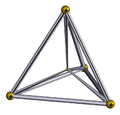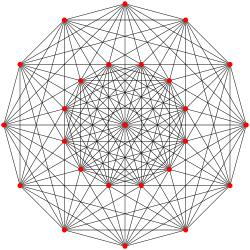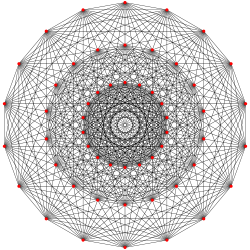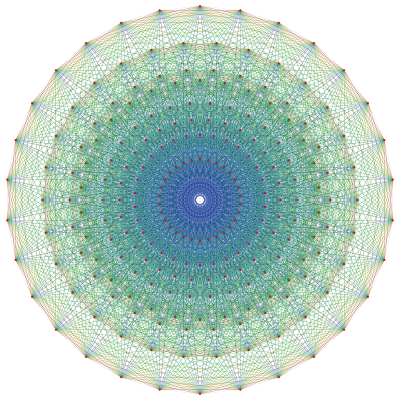
Semiregular E-polytope
Encyclopedia
In geometry
, a uniform k21 polytope is a polytope
in k + 4 dimensions constructed from the En
Coxeter group
, and having only regular polytope
facets. The family was named by Coxeter as k21 by its bifurcating Coxeter–Dynkin diagram, with a single ring on the end of the k-node sequence.
Thorold Gosset
discovered this family as a part of his 1900 enumeration of the regular and semiregular polytopes, and so they are sometimes called Gosset's semiregular figures. Gosset named them by their dimension from 5 to 9, for example the 5-ic semiregular figure.
. (A final form was not discovered by Gosset and is called the E9 lattice: 621. It is a tessellation of hyperbolic 9-space constructed of (∞ 9-simplex
and ∞ 9-orthoplex facets with all vertices at infinity.)
The family starts uniquely as 6-polytope
s. The triangular prism and rectified 5-cell are included at the beginning for completeness. The demipenteract also exists in the demihypercube family.
They are also sometimes named by their symmetry group, like E6 polytope, although there are many uniform polytope
s within the E6 symmetry.
The complete family of Gosset semiregular polytopes are:
Each polytope is constructed from (n − 1)-simplex
and (n − 1)-orthoplex facets.
The orthoplex faces are constructed from the Coxeter group
Dn−1 and have a Schlafli symbol of {31,n−1,1} rather than the regular {3n−2,4}. This construction is an implication of two "facet types". Half the facets around each orthoplex ridge
are attached to another orthoplex, and the others are attached to a simplex. In contrast, every simplex ridge is attached to an orthoplex.
Each has a vertex figure
as the previous form. For example the rectified 5-cell has a vertex figure as a triangular prism.
Geometry
Geometry arose as the field of knowledge dealing with spatial relationships. Geometry was one of the two fields of pre-modern mathematics, the other being the study of numbers ....
, a uniform k21 polytope is a polytope
Polytope
In elementary geometry, a polytope is a geometric object with flat sides, which exists in any general number of dimensions. A polygon is a polytope in two dimensions, a polyhedron in three dimensions, and so on in higher dimensions...
in k + 4 dimensions constructed from the En
En (Lie algebra)
In mathematics, especially in Lie theory, En is the Kac–Moody algebra whose Dynkin diagram is a bifurcating graph with three branches of length 1,2, and k, with k=n-4....
Coxeter group
Coxeter group
In mathematics, a Coxeter group, named after H.S.M. Coxeter, is an abstract group that admits a formal description in terms of mirror symmetries. Indeed, the finite Coxeter groups are precisely the finite Euclidean reflection groups; the symmetry groups of regular polyhedra are an example...
, and having only regular polytope
Regular polytope
In mathematics, a regular polytope is a polytope whose symmetry is transitive on its flags, thus giving it the highest degree of symmetry. All its elements or j-faces — cells, faces and so on — are also transitive on the symmetries of the polytope, and are regular polytopes of...
facets. The family was named by Coxeter as k21 by its bifurcating Coxeter–Dynkin diagram, with a single ring on the end of the k-node sequence.
Thorold Gosset
Thorold Gosset
Thorold Gosset was an English lawyer and an amateur mathematician. In mathematics, he is noted for discovering and classifying the semiregular polytopes in dimensions four and higher.According to H. S. M...
discovered this family as a part of his 1900 enumeration of the regular and semiregular polytopes, and so they are sometimes called Gosset's semiregular figures. Gosset named them by their dimension from 5 to 9, for example the 5-ic semiregular figure.
Family members
The sequence as identified by Gosset ends as an infinite tessellation (space-filling honeycomb) in 8-space, called the E8 latticeE8 lattice
In mathematics, the E8 lattice is a special lattice in R8. It can be characterized as the unique positive-definite, even, unimodular lattice of rank 8...
. (A final form was not discovered by Gosset and is called the E9 lattice: 621. It is a tessellation of hyperbolic 9-space constructed of (∞ 9-simplex
Simplex
In geometry, a simplex is a generalization of the notion of a triangle or tetrahedron to arbitrary dimension. Specifically, an n-simplex is an n-dimensional polytope which is the convex hull of its n + 1 vertices. For example, a 2-simplex is a triangle, a 3-simplex is a tetrahedron,...
and ∞ 9-orthoplex facets with all vertices at infinity.)
The family starts uniquely as 6-polytope
6-polytope
In six-dimensional geometry, a uniform polypeton is a six-dimensional uniform polytope. A uniform polypeton is vertex-transitive, and all facets are uniform polytera....
s. The triangular prism and rectified 5-cell are included at the beginning for completeness. The demipenteract also exists in the demihypercube family.
They are also sometimes named by their symmetry group, like E6 polytope, although there are many uniform polytope
Uniform polytope
A uniform polytope is a vertex-transitive polytope made from uniform polytope facets of a lower dimension. Uniform polytopes of 2 dimensions are the regular polygons....
s within the E6 symmetry.
The complete family of Gosset semiregular polytopes are:
- triangular prismTriangular prismIn geometry, a triangular prism is a three-sided prism; it is a polyhedron made of a triangular base, a translated copy, and 3 faces joining corresponding sides....
: −121 (2 triangleTriangleA triangle is one of the basic shapes of geometry: a polygon with three corners or vertices and three sides or edges which are line segments. A triangle with vertices A, B, and C is denoted ....
s and 3 squareSquare (geometry)In geometry, a square is a regular quadrilateral. This means that it has four equal sides and four equal angles...
faces) - rectified 5-cellRectified 5-cellIn four dimensional geometry, the rectified 5-cell is a uniform polychoron composed of 5 regular tetrahedral and 5 regular octahedral cells. Each edge has one tetrahedron and two octahedra. Each vertex has two tetrahedra and three octahedra. In total it has 30 triangle faces, 30 edges, and 10...
: 021, Tetroctahedric (5 tetrahedraTetrahedronIn geometry, a tetrahedron is a polyhedron composed of four triangular faces, three of which meet at each vertex. A regular tetrahedron is one in which the four triangles are regular, or "equilateral", and is one of the Platonic solids...
and 5 octahedraOctahedronIn geometry, an octahedron is a polyhedron with eight faces. A regular octahedron is a Platonic solid composed of eight equilateral triangles, four of which meet at each vertex....
cells) - demipenteractDemipenteractIn five dimensional geometry, a demipenteract or 5-demicube is a semiregular 5-polytope, constructed from a 5-hypercube with alternated vertices deleted.It was discovered by Thorold Gosset...
: 121, 5-ic semiregular figure (16 5-cell and 10 16-cell16-cellIn four dimensional geometry, a 16-cell or hexadecachoron is a regular convex 4-polytope. It is one of the six regular convex 4-polytopes first described by the Swiss mathematician Ludwig Schläfli in the mid-19th century....
facets) - 2 21 polytope: 221, 6-ic semiregular figure (72 5-simplexSimplexIn geometry, a simplex is a generalization of the notion of a triangle or tetrahedron to arbitrary dimension. Specifically, an n-simplex is an n-dimensional polytope which is the convex hull of its n + 1 vertices. For example, a 2-simplex is a triangle, a 3-simplex is a tetrahedron,...
and 27 5-orthoplex facets) - 3 21 polytope: 321, 7-ic semiregular figure (567 6-simplexSimplexIn geometry, a simplex is a generalization of the notion of a triangle or tetrahedron to arbitrary dimension. Specifically, an n-simplex is an n-dimensional polytope which is the convex hull of its n + 1 vertices. For example, a 2-simplex is a triangle, a 3-simplex is a tetrahedron,...
and 126 6-orthoplex facets) - 4 21 polytope: 421, 8-ic semiregular figure (17280 7-simplexSimplexIn geometry, a simplex is a generalization of the notion of a triangle or tetrahedron to arbitrary dimension. Specifically, an n-simplex is an n-dimensional polytope which is the convex hull of its n + 1 vertices. For example, a 2-simplex is a triangle, a 3-simplex is a tetrahedron,...
and 2160 7-orthoplex facets) - 5 21 honeycomb5 21 honeycombIn geometry, the 521 honeycomb is a uniform tessellation of 8-dimensional Euclidean space.This honeycomb was first studied by Gosset who called it a 9-ic semi-regular figure...
: 521, 9-ic semiregular check tessellates Euclidean 8-space (∞ 8-simplexSimplexIn geometry, a simplex is a generalization of the notion of a triangle or tetrahedron to arbitrary dimension. Specifically, an n-simplex is an n-dimensional polytope which is the convex hull of its n + 1 vertices. For example, a 2-simplex is a triangle, a 3-simplex is a tetrahedron,...
and ∞ 8-orthoplex facets) - 6 21 honeycomb: 621, tessellates hyperbolic 9-space (∞ 9-simplexSimplexIn geometry, a simplex is a generalization of the notion of a triangle or tetrahedron to arbitrary dimension. Specifically, an n-simplex is an n-dimensional polytope which is the convex hull of its n + 1 vertices. For example, a 2-simplex is a triangle, a 3-simplex is a tetrahedron,...
and ∞ 9-orthoplex facets)
Each polytope is constructed from (n − 1)-simplex
Simplex
In geometry, a simplex is a generalization of the notion of a triangle or tetrahedron to arbitrary dimension. Specifically, an n-simplex is an n-dimensional polytope which is the convex hull of its n + 1 vertices. For example, a 2-simplex is a triangle, a 3-simplex is a tetrahedron,...
and (n − 1)-orthoplex facets.
The orthoplex faces are constructed from the Coxeter group
Coxeter group
In mathematics, a Coxeter group, named after H.S.M. Coxeter, is an abstract group that admits a formal description in terms of mirror symmetries. Indeed, the finite Coxeter groups are precisely the finite Euclidean reflection groups; the symmetry groups of regular polyhedra are an example...
Dn−1 and have a Schlafli symbol of {31,n−1,1} rather than the regular {3n−2,4}. This construction is an implication of two "facet types". Half the facets around each orthoplex ridge
Ridge (geometry)
In geometry, a ridge is an -dimensional element of an n-dimensional polytope. It is also sometimes called a subfacet for having one lower dimension than a facet.By dimension, this corresponds to:*a vertex of a polygon;...
are attached to another orthoplex, and the others are attached to a simplex. In contrast, every simplex ridge is attached to an orthoplex.
Each has a vertex figure
Vertex figure
In geometry a vertex figure is, broadly speaking, the figure exposed when a corner of a polyhedron or polytope is sliced off.-Definitions - theme and variations:...
as the previous form. For example the rectified 5-cell has a vertex figure as a triangular prism.
Elements
| n-ic | k21 | Graph Graph (mathematics) In mathematics, a graph is an abstract representation of a set of objects where some pairs of the objects are connected by links. The interconnected objects are represented by mathematical abstractions called vertices, and the links that connect some pairs of vertices are called edges... |
Name Coxeter-Dynkin diagram Coxeter-Dynkin diagram In geometry, a Coxeter–Dynkin diagram is a graph with numerically labeled edges representing the spatial relations between a collection of mirrors... |
Facets Facet (mathematics) A facet of a simplicial complex is a maximal simplex.In the general theory of polyhedra and polytopes, two conflicting meanings are currently jostling for acceptability:... |
Elements | ||||||||
|---|---|---|---|---|---|---|---|---|---|---|---|---|---|
| (n − 1)-simplex Simplex In geometry, a simplex is a generalization of the notion of a triangle or tetrahedron to arbitrary dimension. Specifically, an n-simplex is an n-dimensional polytope which is the convex hull of its n + 1 vertices. For example, a 2-simplex is a triangle, a 3-simplex is a tetrahedron,... {3n−2} |
(n − 1)-orthoplex {3n−4,1,1} |
Vertices Vertex (geometry) In geometry, a vertex is a special kind of point that describes the corners or intersections of geometric shapes.-Of an angle:... |
Edges Edge (geometry) In geometry, an edge is a one-dimensional line segment joining two adjacent zero-dimensional vertices in a polygon. Thus applied, an edge is a connector for a one-dimensional line segment and two zero-dimensional objects.... |
Faces Face (geometry) In geometry, a face of a polyhedron is any of the polygons that make up its boundaries. For example, any of the squares that bound a cube is a face of the cube... |
Cells Cell (geometry) In geometry, a cell is a three-dimensional element that is part of a higher-dimensional object.- In polytopes :A cell is a three-dimensional polyhedron element that is part of the boundary of a higher-dimensional polytope, such as a polychoron or honeycomb For example, a cubic honeycomb is made... |
4-faces | 5-faces | 6-faces | 7-faces | ||||
| 3-ic | −121 |  |
Triangular prism Triangular prism In geometry, a triangular prism is a three-sided prism; it is a polyhedron made of a triangular base, a translated copy, and 3 faces joining corresponding sides.... |
2 triangle Triangle A triangle is one of the basic shapes of geometry: a polygon with three corners or vertices and three sides or edges which are line segments. A triangle with vertices A, B, and C is denoted .... s  |
3 squares Square (geometry) In geometry, a square is a regular quadrilateral. This means that it has four equal sides and four equal angles...  |
6 | 9 | 5 | |||||
| 4-ic | 021 |  |
Rectified 5-cell Rectified 5-cell In four dimensional geometry, the rectified 5-cell is a uniform polychoron composed of 5 regular tetrahedral and 5 regular octahedral cells. Each edge has one tetrahedron and two octahedra. Each vertex has two tetrahedra and three octahedra. In total it has 30 triangle faces, 30 edges, and 10... |
5 tetrahedron Tetrahedron In geometry, a tetrahedron is a polyhedron composed of four triangular faces, three of which meet at each vertex. A regular tetrahedron is one in which the four triangles are regular, or "equilateral", and is one of the Platonic solids...  |
5 octahedron Octahedron In geometry, an octahedron is a polyhedron with eight faces. A regular octahedron is a Platonic solid composed of eight equilateral triangles, four of which meet at each vertex....  |
10 | 30 | 30 | 10 | ||||
| 5-ic | 121 |  |
Demipenteract Demipenteract In five dimensional geometry, a demipenteract or 5-demicube is a semiregular 5-polytope, constructed from a 5-hypercube with alternated vertices deleted.It was discovered by Thorold Gosset... |
16 5-cell |
10 16-cell 16-cell In four dimensional geometry, a 16-cell or hexadecachoron is a regular convex 4-polytope. It is one of the six regular convex 4-polytopes first described by the Swiss mathematician Ludwig Schläfli in the mid-19th century....  |
16 | 80 | 160 | 120 | 26 | |||
| 6-ic | 221 |  |
221 polytope |
72 5-simplexes |
27 5-orthoplexes |
27 | 216 | 720 | 1080 | 648 | 99 | ||
| 7-ic | 321 |  |
321 polytope |
576 6-simplexes |
126 6-orthoplexes |
56 | 756 | 4032 | 10080 | 12096 | 6048 | 702 | |
| 8-ic | 421 |  |
421 polytope |
17280 7-simplexes |
2160 7-orthoplexes |
240 | 6720 | 60480 | 241920 | 483840 | 483840 | 207360 | 19440 |
| 9-ic | 521 |
521 honeycomb 5 21 honeycomb In geometry, the 521 honeycomb is a uniform tessellation of 8-dimensional Euclidean space.This honeycomb was first studied by Gosset who called it a 9-ic semi-regular figure... |
∞ 8-simplexes |
∞ 8-orthoplexes |
∞ | ||||||||
| 10-ic | 621 |
621 honeycomb |
∞ 9-simplexes |
∞ 9-orthoplexes |
∞ | ||||||||
See also
- Uniform 2k1 polytopeUniform 2 k1 polytopeIn geometry, 2k1 polytope is a uniform polytope in n dimensions constructed from the En Coxeter group. The family was named by Coxeter as 2k1 by its bifurcating Coxeter-Dynkin diagram, with a single ring on the end of the 2-node sequence...
family - Uniform 1k2 polytopeUniform 1 k2 polytopeIn geometry, 1k2 polytope is a uniform polytope in n-dimensions constructed from the En Coxeter group. The family was named by Coxeter as 1k2 by its bifurcating Coxeter-Dynkin diagram, with a single ring on the end of the 1-node sequence...
family

